This is a fixed-text formatted version of a Jupyter notebook
You may download all the notebooks in the documentation as a tar file.
Source files: cta_data_analysis.ipynb | cta_data_analysis.py
Basic image exploration and fitting¶
Introduction¶
This notebook shows an example how to make a sky image and spectrum for simulated CTA data with Gammapy.
The dataset we will use is three observation runs on the Galactic center. This is a tiny (and thus quick to process and play with and learn) subset of the simulated CTA dataset that was produced for the first data challenge in August 2017.
Setup¶
As usual, we’ll start with some setup …
[1]:
%matplotlib inline
import matplotlib.pyplot as plt
[2]:
!gammapy info --no-envvar --no-system
Gammapy package:
version : 0.19
path : /Users/adonath/github/adonath/gammapy/gammapy
Other packages:
numpy : 1.21.4
scipy : 1.7.1
astropy : 4.3.1
regions : 0.5
click : 8.0.3
yaml : 6.0
IPython : 7.29.0
jupyterlab : 3.2.2
matplotlib : 3.4.3
pandas : 1.3.4
healpy : 1.15.0
iminuit : 2.8.4
sherpa : 4.14.0
naima : 0.10.0
emcee : 3.1.1
corner : 2.2.1
[3]:
import numpy as np
import astropy.units as u
from astropy.coordinates import SkyCoord
from regions import CircleSkyRegion
from gammapy.modeling import Fit
from gammapy.data import DataStore
from gammapy.datasets import (
Datasets,
FluxPointsDataset,
SpectrumDataset,
MapDataset,
)
from gammapy.modeling.models import (
PowerLawSpectralModel,
SkyModel,
GaussianSpatialModel,
)
from gammapy.maps import MapAxis, WcsGeom, RegionGeom
from gammapy.makers import (
MapDatasetMaker,
SafeMaskMaker,
SpectrumDatasetMaker,
ReflectedRegionsBackgroundMaker,
)
from gammapy.estimators import TSMapEstimator, FluxPointsEstimator
from gammapy.estimators.utils import find_peaks
from gammapy.visualization import plot_spectrum_datasets_off_regions
[4]:
# Configure the logger, so that the spectral analysis
# isn't so chatty about what it's doing.
import logging
logging.basicConfig()
log = logging.getLogger("gammapy.spectrum")
log.setLevel(logging.ERROR)
Select observations¶
A Gammapy analysis usually starts by creating a gammapy.data.DataStore and selecting observations.
This is shown in detail in the other notebook, here we just pick three observations near the galactic center.
[5]:
data_store = DataStore.from_dir("$GAMMAPY_DATA/cta-1dc/index/gps")
[6]:
# Just as a reminder: this is how to select observations
# from astropy.coordinates import SkyCoord
# table = data_store.obs_table
# pos_obs = SkyCoord(table['GLON_PNT'], table['GLAT_PNT'], frame='galactic', unit='deg')
# pos_target = SkyCoord(0, 0, frame='galactic', unit='deg')
# offset = pos_target.separation(pos_obs).deg
# mask = (1 < offset) & (offset < 2)
# table = table[mask]
# table.show_in_browser(jsviewer=True)
[7]:
obs_id = [110380, 111140, 111159]
observations = data_store.get_observations(obs_id)
WARNING:gammapy.data.hdu_index_table:No HDU found matching: OBS_ID = 110380, HDU_TYPE = rad_max, HDU_CLASS = None
WARNING:gammapy.data.hdu_index_table:No HDU found matching: OBS_ID = 111140, HDU_TYPE = rad_max, HDU_CLASS = None
WARNING:gammapy.data.hdu_index_table:No HDU found matching: OBS_ID = 111159, HDU_TYPE = rad_max, HDU_CLASS = None
[8]:
obs_cols = ["OBS_ID", "GLON_PNT", "GLAT_PNT", "LIVETIME"]
data_store.obs_table.select_obs_id(obs_id)[obs_cols]
[8]:
| OBS_ID | GLON_PNT | GLAT_PNT | LIVETIME |
|---|---|---|---|
| deg | deg | s | |
| int64 | float64 | float64 | float64 |
| 110380 | 359.9999912037958 | -1.299995937905366 | 1764.0 |
| 111140 | 358.4999833830074 | 1.3000020211954284 | 1764.0 |
| 111159 | 1.5000056568267741 | 1.299940468335294 | 1764.0 |
Make sky images¶
Define map geometry¶
Select the target position and define an ON region for the spectral analysis
[9]:
axis = MapAxis.from_edges(
np.logspace(-1.0, 1.0, 10), unit="TeV", name="energy", interp="log"
)
geom = WcsGeom.create(
skydir=(0, 0), npix=(500, 400), binsz=0.02, frame="galactic", axes=[axis]
)
geom
[9]:
WcsGeom
axes : ['lon', 'lat', 'energy']
shape : (500, 400, 9)
ndim : 3
frame : galactic
projection : CAR
center : 0.0 deg, 0.0 deg
width : 10.0 deg x 8.0 deg
wcs ref : 0.0 deg, 0.0 deg
Compute images¶
[10]:
%%time
stacked = MapDataset.create(geom=geom)
stacked.edisp = None
maker = MapDatasetMaker(selection=["counts", "background", "exposure", "psf"])
maker_safe_mask = SafeMaskMaker(methods=["offset-max"], offset_max=2.5 * u.deg)
for obs in observations:
cutout = stacked.cutout(obs.pointing_radec, width="5 deg")
dataset = maker.run(cutout, obs)
dataset = maker_safe_mask.run(dataset, obs)
stacked.stack(dataset)
WARNING:gammapy.irf.background:Invalid unit found in background table! Assuming (s-1 MeV-1 sr-1)
WARNING:gammapy.irf.background:Invalid unit found in background table! Assuming (s-1 MeV-1 sr-1)
WARNING:gammapy.irf.background:Invalid unit found in background table! Assuming (s-1 MeV-1 sr-1)
WARNING:gammapy.irf.background:Invalid unit found in background table! Assuming (s-1 MeV-1 sr-1)
WARNING:gammapy.irf.background:Invalid unit found in background table! Assuming (s-1 MeV-1 sr-1)
WARNING:gammapy.irf.background:Invalid unit found in background table! Assuming (s-1 MeV-1 sr-1)
CPU times: user 1.35 s, sys: 119 ms, total: 1.47 s
Wall time: 1.47 s
[11]:
# The maps are cubes, with an energy axis.
# Let's also make some images:
dataset_image = stacked.to_image()
Show images¶
Let’s have a quick look at the images we computed …
[12]:
dataset_image.counts.smooth(2).plot(vmax=5);
/Users/adonath/software/mambaforge/envs/gammapy-dev/lib/python3.9/site-packages/astropy/visualization/wcsaxes/core.py:211: MatplotlibDeprecationWarning: Passing parameters norm and vmin/vmax simultaneously is deprecated since 3.3 and will become an error two minor releases later. Please pass vmin/vmax directly to the norm when creating it.
return super().imshow(X, *args, origin=origin, **kwargs)

[13]:
dataset_image.background.plot(vmax=5);
/Users/adonath/software/mambaforge/envs/gammapy-dev/lib/python3.9/site-packages/astropy/visualization/wcsaxes/core.py:211: MatplotlibDeprecationWarning: Passing parameters norm and vmin/vmax simultaneously is deprecated since 3.3 and will become an error two minor releases later. Please pass vmin/vmax directly to the norm when creating it.
return super().imshow(X, *args, origin=origin, **kwargs)
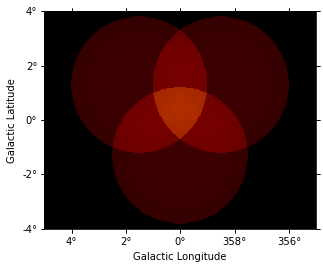
[14]:
dataset_image.excess.smooth(3).plot(vmax=2);
/Users/adonath/software/mambaforge/envs/gammapy-dev/lib/python3.9/site-packages/astropy/visualization/wcsaxes/core.py:211: MatplotlibDeprecationWarning: Passing parameters norm and vmin/vmax simultaneously is deprecated since 3.3 and will become an error two minor releases later. Please pass vmin/vmax directly to the norm when creating it.
return super().imshow(X, *args, origin=origin, **kwargs)
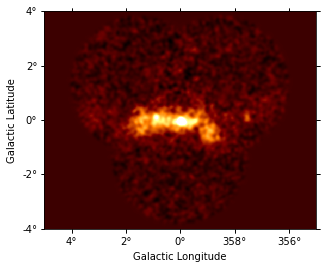
Source Detection¶
Use the class gammapy.estimators.TSMapEstimator and function gammapy.estimators.utils.find_peaks to detect sources on the images. We search for 0.1 deg sigma gaussian sources in the dataset.
[15]:
spatial_model = GaussianSpatialModel(sigma="0.05 deg")
spectral_model = PowerLawSpectralModel(index=2)
model = SkyModel(spatial_model=spatial_model, spectral_model=spectral_model)
[16]:
ts_image_estimator = TSMapEstimator(
model,
kernel_width="0.5 deg",
selection_optional=[],
downsampling_factor=2,
sum_over_energy_groups=False,
energy_edges=[0.1, 10] * u.TeV,
)
[17]:
%%time
images_ts = ts_image_estimator.run(stacked)
CPU times: user 3.95 s, sys: 92.8 ms, total: 4.04 s
Wall time: 3.78 s
[18]:
sources = find_peaks(
images_ts["sqrt_ts"],
threshold=5,
min_distance="0.2 deg",
)
sources
[18]:
| value | x | y | ra | dec |
|---|---|---|---|---|
| deg | deg | |||
| float64 | int64 | int64 | float64 | float64 |
| 35.938 | 252 | 197 | 266.42400 | -29.00490 |
| 17.9 | 207 | 202 | 266.85900 | -28.18386 |
| 12.763 | 186 | 200 | 267.14365 | -27.84496 |
| 9.9763 | 373 | 205 | 264.79470 | -30.97749 |
| 8.6623 | 306 | 185 | 266.01081 | -30.05120 |
| 8.0457 | 298 | 169 | 266.42267 | -30.08192 |
| 7.3818 | 274 | 217 | 265.77047 | -29.17056 |
| 6.6922 | 90 | 209 | 268.07455 | -26.10409 |
| 5.0223 | 87 | 226 | 267.78333 | -25.87897 |
[19]:
source_pos = SkyCoord(sources["ra"], sources["dec"])
source_pos
[19]:
<SkyCoord (ICRS): (ra, dec) in deg
[(266.42399798, -29.00490483), (266.85900392, -28.18385658),
(267.14365055, -27.84495923), (264.79469899, -30.97749371),
(266.01080642, -30.05120198), (266.4226731 , -30.08192101),
(265.77046935, -29.1705559 ), (268.07454639, -26.10409446),
(267.78332719, -25.87897418)]>
[20]:
# Plot sources on top of significance sky image
images_ts["sqrt_ts"].plot(add_cbar=True)
plt.gca().scatter(
source_pos.ra.deg,
source_pos.dec.deg,
transform=plt.gca().get_transform("icrs"),
color="none",
edgecolor="white",
marker="o",
s=200,
lw=1.5,
);
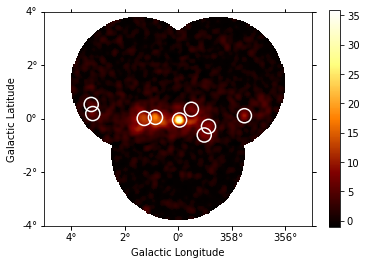
Spatial analysis¶
See other notebooks for how to run a 3D cube or 2D image based analysis.
Spectrum¶
We’ll run a spectral analysis using the classical reflected regions background estimation method, and using the on-off (often called WSTAT) likelihood function.
[21]:
target_position = SkyCoord(0, 0, unit="deg", frame="galactic")
on_radius = 0.2 * u.deg
on_region = CircleSkyRegion(center=target_position, radius=on_radius)
[22]:
exclusion_mask = ~geom.to_image().region_mask([on_region])
exclusion_mask.plot();
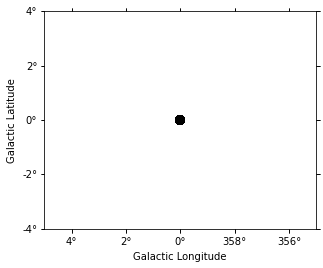
[23]:
energy_axis = MapAxis.from_energy_bounds(
0.1, 40, 40, unit="TeV", name="energy"
)
energy_axis_true = MapAxis.from_energy_bounds(
0.05, 100, 200, unit="TeV", name="energy_true"
)
geom = RegionGeom.create(region=on_region, axes=[energy_axis])
dataset_empty = SpectrumDataset.create(
geom=geom, energy_axis_true=energy_axis_true
)
[24]:
dataset_maker = SpectrumDatasetMaker(
containment_correction=False, selection=["counts", "exposure", "edisp"]
)
bkg_maker = ReflectedRegionsBackgroundMaker(exclusion_mask=exclusion_mask)
safe_mask_masker = SafeMaskMaker(methods=["aeff-max"], aeff_percent=10)
[25]:
%%time
datasets = Datasets()
for observation in observations:
dataset = dataset_maker.run(
dataset_empty.copy(name=f"obs-{observation.obs_id}"), observation
)
dataset_on_off = bkg_maker.run(dataset, observation)
dataset_on_off = safe_mask_masker.run(dataset_on_off, observation)
datasets.append(dataset_on_off)
CPU times: user 2.26 s, sys: 108 ms, total: 2.37 s
Wall time: 2.09 s
[26]:
plt.figure(figsize=(8, 8))
ax = dataset_image.counts.smooth("0.03 deg").plot(vmax=8)
on_region.to_pixel(ax.wcs).plot(ax=ax, edgecolor="white")
plot_spectrum_datasets_off_regions(datasets, ax=ax)
/Users/adonath/software/mambaforge/envs/gammapy-dev/lib/python3.9/site-packages/astropy/visualization/wcsaxes/core.py:211: MatplotlibDeprecationWarning: Passing parameters norm and vmin/vmax simultaneously is deprecated since 3.3 and will become an error two minor releases later. Please pass vmin/vmax directly to the norm when creating it.
return super().imshow(X, *args, origin=origin, **kwargs)
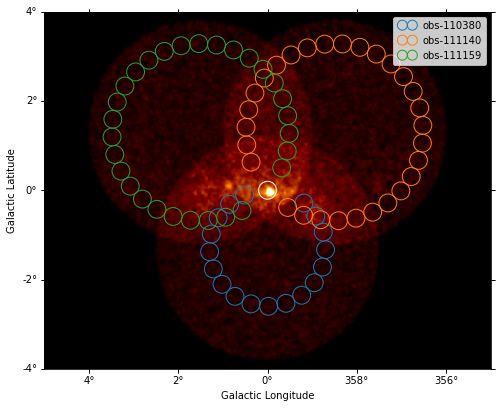
Model fit¶
The next step is to fit a spectral model, using all data (i.e. a “global” fit, using all energies).
[27]:
%%time
spectral_model = PowerLawSpectralModel(
index=2, amplitude=1e-11 * u.Unit("cm-2 s-1 TeV-1"), reference=1 * u.TeV
)
model = SkyModel(spectral_model=spectral_model, name="source-gc")
datasets.models = model
fit = Fit()
result = fit.run(datasets=datasets)
print(result)
OptimizeResult
backend : minuit
method : migrad
success : True
message : Optimization terminated successfully.
nfev : 104
total stat : 88.36
OptimizeResult
backend : minuit
method : migrad
success : True
message : Optimization terminated successfully.
nfev : 104
total stat : 88.36
CPU times: user 886 ms, sys: 44.2 ms, total: 931 ms
Wall time: 676 ms
Spectral points¶
Finally, let’s compute spectral points. The method used is to first choose an energy binning, and then to do a 1-dim likelihood fit / profile to compute the flux and flux error.
[28]:
# Flux points are computed on stacked observation
stacked_dataset = datasets.stack_reduce(name="stacked")
print(stacked_dataset)
SpectrumDatasetOnOff
--------------------
Name : stacked
Total counts : 413
Total background counts : 85.43
Total excess counts : 327.57
Predicted counts : 98.34
Predicted background counts : 98.34
Predicted excess counts : nan
Exposure min : 9.94e+07 m2 s
Exposure max : 2.46e+10 m2 s
Number of total bins : 40
Number of fit bins : 30
Fit statistic type : wstat
Fit statistic value (-2 log(L)) : 658.76
Number of models : 0
Number of parameters : 0
Number of free parameters : 0
Total counts_off : 2095
Acceptance : 40
Acceptance off : 990
[29]:
energy_edges = MapAxis.from_energy_bounds("1 TeV", "30 TeV", nbin=5).edges
stacked_dataset.models = model
fpe = FluxPointsEstimator(energy_edges=energy_edges, source="source-gc")
flux_points = fpe.run(datasets=[stacked_dataset])
flux_points.to_table(sed_type="dnde", formatted=True)
[29]:
| e_ref | e_min | e_max | dnde | dnde_err | ts | sqrt_ts | npred [1] | npred_excess [1] | stat | is_ul | counts [1] | success |
|---|---|---|---|---|---|---|---|---|---|---|---|---|
| TeV | TeV | TeV | 1 / (cm2 s TeV) | 1 / (cm2 s TeV) | ||||||||
| float64 | float64 | float64 | float64 | float64 | float64 | float64 | float64 | float32 | float64 | bool | float64 | bool |
| 1.375 | 0.946 | 2.000 | 1.447e-12 | 1.783e-13 | 152.513 | 12.350 | 105.77522448802759 | 83.89892 | 13.412 | False | 106.0 | True |
| 2.699 | 2.000 | 3.641 | 3.563e-13 | 4.835e-14 | 150.654 | 12.274 | 73.0251191213776 | 63.13247 | 2.245 | False | 73.0 | True |
| 5.295 | 3.641 | 7.700 | 7.332e-14 | 1.138e-14 | 121.570 | 11.026 | 53.98359208452403 | 47.455875 | 0.624 | False | 54.0 | True |
| 11.198 | 7.700 | 16.284 | 6.353e-15 | 2.154e-15 | 21.789 | 4.668 | 13.188429838204122 | 10.660447 | 5.744 | False | 13.0 | True |
| 21.971 | 16.284 | 29.645 | 1.109e-15 | 6.938e-16 | 6.250 | 2.500 | 4.145310538807671 | 3.197989 | 2.899 | False | 4.0 | True |
Plot¶
Let’s plot the spectral model and points. You could do it directly, but for convenience we bundle the model and the flux points in a FluxPointDataset:
[30]:
flux_points_dataset = FluxPointsDataset(data=flux_points, models=model)
[31]:
flux_points_dataset.plot_fit();
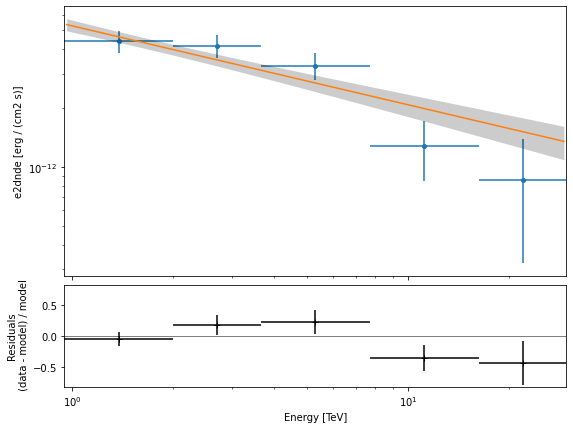
Exercises¶
Re-run the analysis above, varying some analysis parameters, e.g.
Select a few other observations
Change the energy band for the map
Change the spectral model for the fit
Change the energy binning for the spectral points
Change the target. Make a sky image and spectrum for your favourite source.
If you don’t know any, the Crab nebula is the “hello world!” analysis of gamma-ray astronomy.
[32]:
# print('hello world')
# SkyCoord.from_name('crab')
What next?¶
This notebook showed an example of a first CTA analysis with Gammapy, using simulated 1DC data.
Let us know if you have any question or issues!
